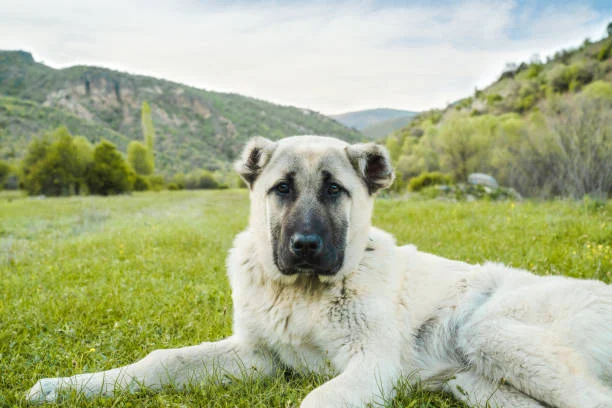Kangal dogs, hailing from the rugged terrain of Turkey, often stir debate due to their immense size and fierce guarding instincts. Weighing between 50–66 kg (110–145 lbs) for males and standing up to 32 inches (81 cm) tall, their intimidating presence leads many to assume they are naturally aggressive. So, are Kangal dogs aggressive, is that really the case? If there’s a fight between Kangal Vs Pitbull, who will win?
I will break down their temperament, delve into the factors that influence their behavior, and explain how you can raise a calm, protective—not aggressive—Kangal.
Quick Navigation
The Kangal Temperament: Loyal, Strong, and Watchful
The Kangal dog is primarily a livestock guardian, bred to protect sheep and goats from predators like wolves and bears in Turkey’s rural regions. These dogs are not bred for fighting or attacking humans, but for vigilance and restraint. Their short, dense coat, black mask, and muscular frame are built for endurance and protection.
Despite their strength, Kangals are generally calm, independent, and highly intelligent. Their default reaction to unfamiliar situations is caution, not hostility. It’s their instinct to assess threats and respond only if necessary. When raised properly, a Kangal is gentle with its family, including children, and forms a tight bond with its household.
Are Kangal Dogs Aggressive? The Myth Vs. Reality
The belief that Kangals are naturally aggressive stems from misunderstanding their territorial instincts. These dogs don’t attack without reason—but they react swiftly if they sense danger.
Instead of aggression, what you’re likely seeing is:
- Guarding behavior: Barking, positioning between their owner and a stranger, or growling at intruders.
- Territoriality: Defending the property or livestock they’ve bonded with.
- Wary of strangers: Not because they’re aggressive, but because they are cautious.
Their aggression, when it does occur, is often context-driven rather than a personality trait. Here is detail:
Top 5 Causes of Aggression in Kangals
Let’s examine the key factors that might lead a Kangal dog to show signs of aggression, alongside real statistics and solutions:
1. Lack of Socialization
80% of aggressive behaviors in dogs can be traced back to poor socialization during puppyhood. If not introduced to new people, animals, and environments early, Kangals can become fearful—and fear often leads to aggression.
Solution: Begin socialization as early as 8 weeks, exposing your pup to varied experiences using positive reinforcement techniques.
2. Poor Training and Obedience
Studies reveal dogs lacking basic obedience are 3x more likely to show aggression. Kangals are independent and won’t naturally obey without firm but kind instruction.
Solution: Use clear commands and positive reinforcement from puppyhood. Enlist a trainer if necessary, especially for first-time Kangal owners.
3. Undiagnosed Pain or Health Issues
A 2021 study in the Journal of Veterinary Behavior found 12% of aggressive incidents were due to undiagnosed health problems like hip dysplasia or arthritis, common in large breeds.
Solution: Routine vet check-ups and pain management can help maintain a Kangal’s gentle temperament.
4. Anxiety or Boredom
Kangals are working dogs. Without stimulation, they can become anxious or frustrated. Dogs that don’t get enough exercise are 5x more likely to show aggressive behavior.
Solution: Provide daily exercise (at least 60–90 minutes), interactive toys, and tasks that mirror guarding or herding behaviors.
5. Protective and Territorial Nature
70% of aggressive incidents in dogs are linked to territorial behavior, as per AKC data. Kangals may react when a stranger enters “their” space—even if there’s no real threat.
Solution: Teach them to differentiate between threats and harmless strangers through training and exposure.
Managing and Preventing Aggression: 4 Essential Steps
You don’t need to suppress your Kangal’s protective instincts—you need to channel them responsibly. Here’s how:

1. Early Socialization & Structured Training
Start from 8 weeks old. Introduce your Kangal to new people, children, pets, and various settings. Use reward-based obedience training to build respect and trust.
2. Provide Mental and Physical Work
Offer 1.5–2 hours of structured activity per day. This could include walks, playtime, basic command drills, or problem-solving games. A bored Kangal is a ticking time bomb of energy.
3. Regular Health Monitoring
Make annual vet visits non-negotiable. For older Kangals (6+ years), schedule checkups every 6 months to detect pain-inducing conditions early.
4. Create a Safe, Predictable Environment
Kangals thrive on routine and clarity. Avoid chaotic or overly busy environments. Provide a quiet space indoors and use a secure, fenced yard if outdoors. Let them know where their territory begins and ends.
Quick Fix Table: Common Behavior Problems & Fast Solutions
| Cause | Quick Fix |
| Overprotectiveness | Early socialization + positive reinforcement |
| Fear or Anxiety | Gradual exposure to stressors in calm environments |
| Lack of Training | Structured obedience classes, consistency |
| Poor Socialization | Controlled interactions with people and animals |
| Territorial Behavior | Boundary-setting, clear commands, secure spaces |
Final Thoughts: Are Kangal Dogs Aggressive?
No—Kangal dogs are not naturally aggressive, but they are deeply protective. Their instincts, strength, and independence require a confident, experienced owner who can provide the right environment. They are among the best livestock guardians in the world, but need structure, love, and discipline to thrive as family pets.
When handled correctly, a Kangal is a gentle giant with its family and a formidable protector when needed. Their loyalty and intelligence make them one of the most respected working breeds globally.
So, to answer the big question—are Kangal dogs aggressive? Only if you neglect their needs. With the right approach, they’ll guard your home without ever becoming a danger within it.

